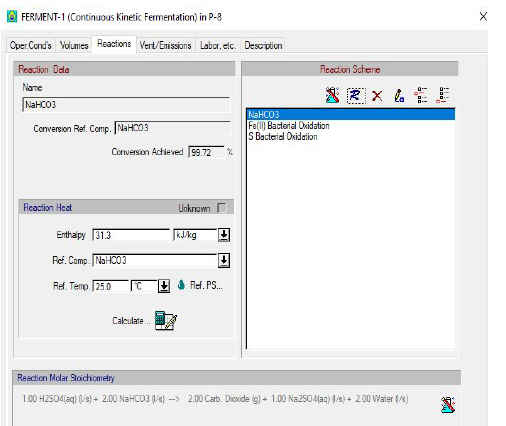

The following table shows a brief description of the variables appearing in this tab. The table also displays their default values and their generally acceptable range:
|
Variable |
Default Value |
Range |
|
|
||
|
● Reaction Name |
Reaction #1 |
User Defined Text |
|
● Reaction-Limiting Comp. |
<none> |
Any Pure Component |
|
● Extent Achieved (%) |
0.0 |
0-100 |
|
○ Ignore Reaction Heat |
Yes |
Yes/No |
|
○ Enthalpy (kcal/kg) |
0.0 |
Any Value |
|
○ Reference Component |
<none> |
Any Pure Component |
|
○ Reference Temp. (oC) |
25.0 |
Positive |
Symbol Key: ○ User-specified value (always input); ● Calculated value (always output); ◙ Sometimes input, sometimes output
The following list describes the available specification choices in this tab; for more details on how these are implemented, please view see Batch Kinetic Reaction: Modeling Calculations.
•Reaction Heat...
Use negative enthalpy values for exothermic (heat releasing) reactions and positive for endothermic (heat absorbing). You can either supply a value here at a given reference temperature and along with the assumed state of participants (see next), or you can invoke the Reaction Enthalpy Calculator (click on  ) that can help you estimate the Reaction Heat from the heats of formation of each participant (and the stoichiometry of the reaction).
) that can help you estimate the Reaction Heat from the heats of formation of each participant (and the stoichiometry of the reaction). This button will bring up the Reaction Enthalpy Calculator Dialog interface which allows you to estimate the reaction enthalpy (heat of reaction) based on the enthalpies of formation of each participant (reactant and product). You can you cannot invoke the Reaction Enthalpy Calculator if:
This button will bring up the Reaction Enthalpy Calculator Dialog interface which allows you to estimate the reaction enthalpy (heat of reaction) based on the enthalpies of formation of each participant (reactant and product). You can you cannot invoke the Reaction Enthalpy Calculator if:
a) a reaction enthalpy reference component has not been selected or,
b) at least one reaction participant component is in the vapor phase at the enthalpy of formation reference temperature (i.e., its normal boiling point is below 25°C) and its vapor parameters have been declared to be ‘Unknown/Irrelevant’.
•Assumed PS of Reaction Participants
SuperPro offers the option to specify the physical state of the reaction participants (at the reaction reference temperature) that corresponds to the user-defined reaction enthalpy. By default, the physical states of the participating components are inferred by the normal boiling point criterion at the reaction reference temperature. Click on the button  to view and edit the physical state of the reaction participants. Please see Reaction Participants PS Dialog.
to view and edit the physical state of the reaction participants. Please see Reaction Participants PS Dialog.
•Reaction Scheme...
You can use the following buttons for editing / rearranging reactions:
 to view/edit the reaction stoichiometry of the selected reaction,
to view/edit the reaction stoichiometry of the selected reaction,
 to view/edit the kinetic data of the reaction,
to view/edit the kinetic data of the reaction,
 to delete the selected reaction,
to delete the selected reaction,
 to rename the selected reaction,
to rename the selected reaction,
 to insert a reaction above the selected one, and
to insert a reaction above the selected one, and
 to add a reaction at the end of the sequence.
to add a reaction at the end of the sequence.
If this Reactions tab is part of a Kinetic Fermentation operation, and the user has defined a Primary Biomass component (see “Special Components”) and the chosen primary biomass component is being produced by any of the reactions listed in the scheme, two more controls appear on the dialog:
1. A drop-down for the selection of ‘Water’ component.
2. The primary biomass water content value (a percentage between (0-100%)).
If a ‘Water’ component is chosen (from the list of registered components), then the reaction’s simulation will automatically transform enough quantity of the chosen ‘Water’ component as intracellular to indicate that the live cells ‘contain’ that amount of ‘Water’. This may be important for further processing of the reaction’s product stream as any downstream step separating the biomass cells, will automatically take with it ‘Water’ in proportion as dictated by the water’s intracellular percentage. If not enough ‘Water’ is present to be associated with the live biomass cells, a warning will be produced. If you don’t want the program to automatically make that association and determine the intracellular percentage of water needed to satisfy the primary biomass water content specification, simply leave the choice for ‘Water’ component as ‘(none)’.
For information on reaction stoichiometry, see Reaction Stoichiometry Balance Dialog and for information on bio-reaction stoichiometry, such as fermentation reactions, see Bio-Reaction Stoichiometry Balance Dialog.
For details on the kinetics data of the reactions, see:
● Fermentation Kinetics Dialog
● Environmental Reaction Kinetics Dialog